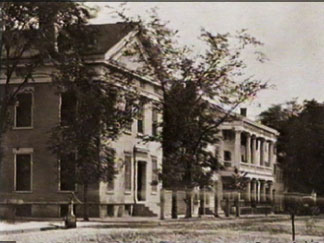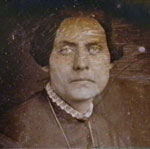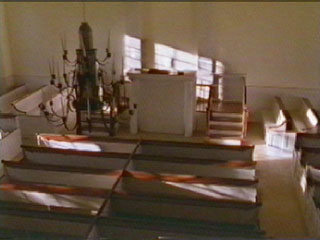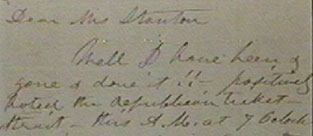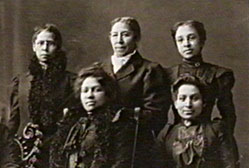| Not For Ourselves Alone: The Story of Elizabeth Cady Stanton and Susan B. Anthony. Video. Produced by Ken Burns and Paul Barnes. Written by Geoffrey C. Ward. 1999.
The first half of the two-part series is stronger than the second. It explores Anthony and Stanton's relationships with their parents, especially their strong-minded fathers, and it traces their economic and religious backgrounds. Anthony did not marry; Stanton did, and soon found herself surrounded by a large and demanding family. The filmmakers portray the struggles and heartaches caused by each woman's choice, illuminating the constraints placed on nineteenth-century women by the ideal of female domesticity.
The first half of the film also traces Anthony and Stanton's journey from the abolitionist movement to the movement for women's rights, including extended coverage of the first women's rights convention, held in 1848 at Seneca Falls, New York. These segments, and another on the fight for legislation to protect married women's property rights, introduce a large cast of historical characters. The filmmakers quote a variety of radical thinkers, from women's rights advocates Lucretia Mott and the Rev. Antoinette Brown to abolitionists Frederick Douglass and Wendell Phillips—whose words are by turns contentious, thoughtful, and inspiring. Once the video passes the Civil War era (to the requisite tune of "Rally Round the Flag"), Not for Ourselves Alone focuses almost solely on suffrage. It offers a brief description of the post-war split between the National Woman Suffrage Association (NWSA), founded by Stanton and Anthony, and the American Woman Suffrage Association (AWSA), led by Lucy Stone Blackwell. It follows the NWSA's legal strategy to its dead end in Minor v. Happersett (1875), when the Supreme Court rejected women's right to vote in federal elections. It then recounts Anthony and Stanton's responses to this decision, and their debates over what strategy to pursue.
What is missing from this documentary is a sense of the complexity of Anthony and Stanton's thought, on both suffrage and its relationship to other issues. This is especially true in its treatment of the early years of Reconstruction when—fresh from an astonishing victory over slavery—so much seemed possible to these radicals; yet the window for reform quickly shut. Distressingly, the film makes no mention of NWSA leaders' 1867 alliance with racist Democrat George Train. It does portray a debate between Stanton and Frederick Douglass, a staunch supporter of women's rights who condemned his ally's description of black men as "Sambos." But Stanton and Anthony's positions are softened here, the implications brushed aside. The filmmakers state, for example, that Anthony warned the nation about the dangers of disfranchising black men—without explaining that she herself had campaigned against enfranchising them. On Anthony's later role in excluding Douglass from a suffrage conference in Atlanta, a move calculated to attract white Southern women, they report only that she "kept silent." Her visit to South Dakota to dedicate a statue to Sacajawea is presented—with no mention of NWSA leaders' earlier speeches, during a Dakota suffrage campaign, denouncing the enfranchisement of "blanketed Indians." To miss this point is to oversimplify the post-Civil War struggles over how women (and which women) were to be enfranchised, and who could properly claim to speak for American womanhood.
In other ways, as well, Not For Ourselves Alone misses the ferment of Anthony and Stanton's agendas during the crucial Reconstruction period. Their concern about the inequities of "free labor" is wholly absent. The issue of women's rights in the workplace—access to the trades and professions, equal pay—surfaces in quotations from the women's writings, but the film does not explain how suffrage related to these goals. Stanton and Anthony's campaign to reform the marriage laws fares better, at least in the first half. A segment on Stanton's proposal in the 1850s to make divorce more accessible to women records the shocked reactions of even her closest allies. One longs for follow-up of this issue in the Reconstruction era, when the NWSA found itself at the center of a maelstrom of debate on marriage, women's sexual rights, and "free love." It seems significant that interviews with historians like Ellen Carol DuBois, who have analyzed Stanton and Anthony's complicated choices during Reconstruction, get far less air time than does the commentary of biographers who address the women's emotions. For the 1880s and 1890s, Barnes and Burns are correct in portraying Anthony as more cautious than Stanton on some questions. They tell the story of Stanton's creation of the Women's Bible in the 1890s and show the intolerance of other suffragists toward a thinker who was far ahead of her time on many matters. But for this era, too, viewers fail to get the full story. Anthony did, as the filmmakers report, seek an early alliance with the Woman's Christian Temperance Union—a typically savvy move—and Stanton was indeed doubtful. A few years later, however, Stanton endorsed the WCTU-backed Prohibition Party while Anthony stuck with the Republicans. Without sufficient context of this sort, viewers may be left wondering what "conservative" and "radical" meant within the movement, and how suffrage, the most radical proposal of 1848, came to be seen as a goal around which all women could unite.
To be fair, it would be hard for any filmmaker to capture in a few hours all aspects of these women's long and complex public careers. Burns and Barnes are hardly alone in their tendency to conflate suffrage and women's rights—to see Stanton and Anthony as leaders of a movement which had one crowning idea and pursued a few peculiar agendas on the side. This is a safe and popular story; woman suffrage is an achievement that everyone now applauds. Its nineteenth-century opponents are easily characterized as benighted and small. Such an analysis not only oversimplifies Stanton and Anthony's politics; it ends up shifting the focus away from them entirely. From the start, this film makes clear that its narrative climax will be the passage of the 19th Amendment, years after Stanton and Anthony passed from the scene. Almost a quarter of the film is about the protagonists' deaths and events that happened afterward. In a purported biography of the two women, this produces odd emphases. Harry Burn, the young Tennessee legislator who contributed the last vote for passage in 1920, gets more attention than does the entire existence of The Revolution, the radical journal Anthony and Stanton edited in the 1870s. This is, in sum, a story of personal sacrifice in the service of goals that are comfortable—even obvious—to Americans today. The dominant emotions are courage, devotion, and determination, with the assurance (provided in the opening frames) of ultimate triumph. This perhaps explains the filmmakers' tender, lingering coverage of Stanton and Anthony's deaths, which I suspect would make both women impatient. In allotting so many minutes to final illnesses, deathbeds, and last words, the documentary is more in tune with Anna Shaw's eulogy for Anthony—"never did more victorous hero go to rest"—than with the sensible advice it quotes from Anthony herself: "pass on, and go on with the work."
As in Burns' earlier projects, video footage adds beauty and color but is eerily still. Church pews and rocking chairs sit empty; government buildings stand silent; roads and rails stretch into the autumn woods, their serenity undisturbed by horses, trains, or people. I confess myself more drawn to re-creations that include grit and sweat, such as the film version of Laurel Thatcher Ulrich's A Midwife's Tale, which is filled with household bustle, laughs and grunts and shouts, and dirty linens airing on the shrubbery. Here, contemporary dagguerotypes make the past feel closer than do the video clips. Coping with a lack of visual material on Stanton and Anthony in their early years, the filmmakers intersperse portraits of ordinary women: textile workers, pioneers, picknickers, students, mothers with children. The effect is to broaden the story and suggest the diversity of women's experience, though it sometimes leaves unanswered questions (who are those girls on horseback, galloping across the Plains, and what did they think about women's rights?). Not for Ourselves Alone makes up for its shortcomings with some profoundly moving passages, quoting from intimate letters and eloquent public statements such as Stanton's "Solitude of Self." Boston society is "a kind of moral museum," the young Stanton reports with humor when she moves to the city. Decades later, watching the rise of a new generation, she expresses her wish to "lag superfluous upon the stage no longer." Anthony describes a breakdown from exhaustion as "the whole of me coming to a standstill, like a thunderclap." "It is all at sea," she writes after Stanton's death. "What a world it is that goes on and on, no matter who lives or who dies." In moments like these, Not for Ourselves Alone helps recapture the experiences and achievements of two extraordinary women, introducing them to an American public which should know more about the struggle for women's rights. Rebecca Edwards Copyright © 2000, 2001 by The Journal for MultiMedia History Comments | JMMH Contents |
